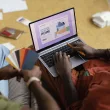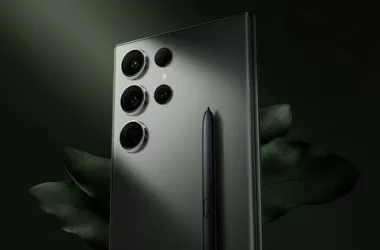At Lenovo Tech World ’23, Motorola unveiled an array of intriguing concepts, leaving us to wonder if these visionary ideas will ever materialize. Motorola, a subsidiary of Lenovo since 2014, introduced an “adaptive display” prototype that can seamlessly transform into a smartphone, a stand, or even a smart bracelet. This innovation builds upon a prototype Lenovo exhibited back in 2016, pushing the boundaries of flexible display technology.
The star of the show is undoubtedly the rollable smartphone featuring an FHD+ pOLED display. This prototype is no ordinary device; it’s designed to adapt to users’ unique needs. It can stretch out flat, functioning as a traditional smartphone. Alternatively, you can bend it partway to place it on a desk, a concept reminiscent of foldable phones. And here’s where it gets truly fascinating – you can wrap this device partially around your wrist, effectively transforming it into a modern version of the iconic slap bracelet.
The concept showcases a remarkable 6.9-inch display and provides a full Android experience, akin to conventional smartphones (with the exception of iPhones). When positioned upright in stand mode, it seamlessly transitions to a more compact Android version, displayed on a 4.6-inch section of the screen.
While the allure of these futuristic innovations is undeniable, it’s important to maintain a level of realism. As of now, it’s uncertain when, or if, these concepts will be available as consumer products. Nevertheless, Lenovo has built a reputation for delivering unconventional and imaginative consumer devices, so it’s not beyond the realm of possibility.
Beyond the flexible prototype, Motorola also introduced a suite of AI-powered concepts. In line with the technological landscape of 2023, the company harnesses generative AI’s capabilities to provide users with an exciting feature – personalized wallpapers. With this concept, users can capture or upload images of their outfits, and AI will create multiple unique images reflecting their style. These AI-generated images can then be transformed into custom wallpapers for your device, adding a new dimension to personalization.
Motorola doesn’t stop at wallpapers; the company is venturing into personal voice and text assistants for PCs and smartphones. Meet MotoAI, an assistant powered by a large language model (LLM). This AI-driven assistant can answer queries, draft messages, schedule tasks, and more, all while prioritizing privacy. By processing data and tasks locally, instead of relying on the cloud, MotoAI aims to provide a unique and personalized experience that becomes increasingly efficient as it learns more about you.
Finally, Motorola is diving into document scanning innovation. They teased a feature that minimizes wrinkles and shadows when scanning physical images or documents using your phone’s camera. This innovation is poised to enhance the quality of the final scanned images, ensuring documents and images appear crisp and clear.
While these concepts are still in the realm of possibilities, they exemplify Motorola’s commitment to pushing the boundaries of technology, offering innovative solutions that could redefine how we interact with our devices in the future.












1 comment